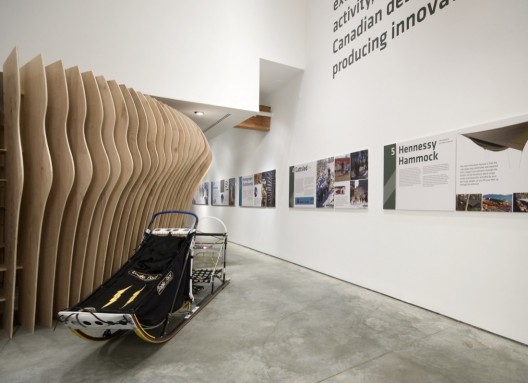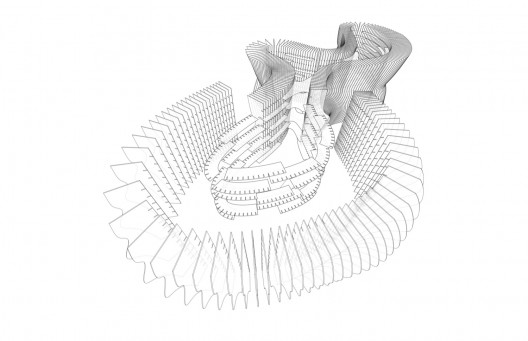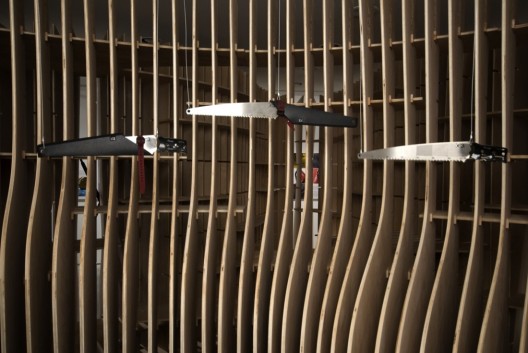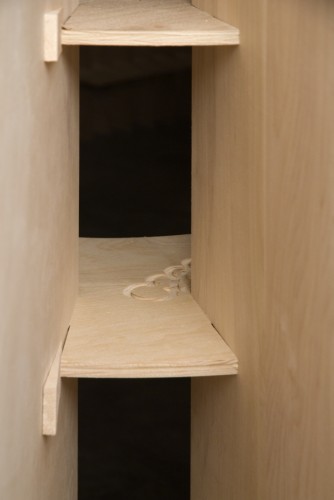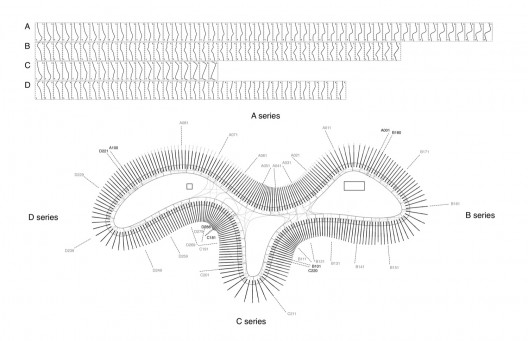Tuesday, February 16, 2010
Just carved this horse with CNC Router
scope for cnc routing - a table design
Designer Julian Kyhl obviously holds a kindship with the earth-friendly lumberjack because this table is one that makes a dude appreciate the fine excellence of a hunk of wood. FSC certified!
4 identical legs, 2 identical crossbars, 2 identical mid-section planks, and 2 identical outer planks. That’s what’s here! And all of these pieces come naturalistic – no glue, no lamination, no screws, no nails.
spaces inter/section
Canadian Architects Campos Leckie Studio shared with us this recent installation for an Exhibition for the 2010 Cultural Olympiad in Vancouver.
Consistent with the exhibition theme of Canadian innovation in design, inter/section demonstrates the potential of contemporary wood fabrication technologies to generate formal variation from standardized wood construction materials within the constraints of material efficiency, ease of assembly/disassembly, and adaptive reuse.
The form of inter/section structures the relationship between the viewer, the exhibition objects, and associated graphic information while specific sections respond to the particular placement and spatial dimensions of each of the objects.
All components in the assembly are joined through interlocking friction connections without the use of fasteners or adhesives. The installation is created using 172 sheets of plywood that were cut using a 3-axis CNC (computer numerically controlled) router. The 288 vertical planes are paired and cut from 144 sheet of plywood. The remaining 28 sheets are used for interlocking horizontal pieces that shape this particular installation.
Developed to be reconfigured in other spaces inter/section employs a standardized placement of interlocking connection slots on the vertical sections. These create a system with a high degree of flexibility that allows the overall reconfiguration of the installation while maintaining the specificity inherent in the vertical sections. The entire assembly can be packaged to fit within a volume of 4’-0” x 8’-0” x 7’-0”.
Consistent with the exhibition theme of Canadian innovation in design, inter/section demonstrates the potential of contemporary wood fabrication technologies to generate formal variation from standardized wood construction materials within the constraints of material efficiency, ease of assembly/disassembly, and adaptive reuse.
The form of inter/section structures the relationship between the viewer, the exhibition objects, and associated graphic information while specific sections respond to the particular placement and spatial dimensions of each of the objects.
All components in the assembly are joined through interlocking friction connections without the use of fasteners or adhesives. The installation is created using 172 sheets of plywood that were cut using a 3-axis CNC (computer numerically controlled) router. The 288 vertical planes are paired and cut from 144 sheet of plywood. The remaining 28 sheets are used for interlocking horizontal pieces that shape this particular installation.
Developed to be reconfigured in other spaces inter/section employs a standardized placement of interlocking connection slots on the vertical sections. These create a system with a high degree of flexibility that allows the overall reconfiguration of the installation while maintaining the specificity inherent in the vertical sections. The entire assembly can be packaged to fit within a volume of 4’-0” x 8’-0” x 7’-0”.
Oregon bike builder crafts frames from wood using CNC Router
Bikes have been around for quite a long time but every now and then bike technology takes a leap.
Ken Wheeler of Portland, Ore, has led his bicycle company in a new direction and that direction is hardwood.
Ken in front of the bamboo fixed gear and several showroom frames.
A complex joint in the rear triangle of a bike; as strong as it is beautiful.
Originally a wood boat and airplane craftsman from Seattle, Ken decided to launch a new career in bicycle crafting after a venture with an old friend dried up.
Before getting into bike building, Ken was a boat builder and airplane designer. The plane in the frame is one he designed.
Ken realized that his passion for design, building, and cyclery could give him an edge.
After some intense research and many late nights Ken realized that he didn’t want to use conventional materials; he wanted to instill in bikes the same sort of craft and artistic eye that went into wood boat making.
Every customer gets to pick the sort of wood that they want to come alive in their bike.
In order to craft bikes these wooden bikes the way that he wanted he had to go out on a limb and invest in a CNC router and that’s exactly what he did.
The enormous CNC router takes up much of the shop space but also accomplishes much of the work.

Sarah, head woodworker and sander extraordinaire looks over some recent templates for frames.
Renovo bikes are different from the antique wooden bikes that people may think of. The old way of building a bike out of wood was to create solid shafts of the material. Not only was this extremely heavy and ungainly but it wasn’t very strong.
Ken decided that instead he would create designs that cored out pieces of solid wood to create hollow forms. All Renovo bikes are constructed out of two cored out pieces of solid wood, which gives them a hollow core, just like any other bike. This structure makes the bikes extremely light, quiet, and exceptionally strong.

The original chunk of wood (on the right) as opposed to the form after the CNC router is done with it (on the left).
Ken does all the design himself but he has found such a market for his wooden bikes in Portland, and even all over the world, that he is expanding his employee base and expects to keep growing and designing for years to come.

Renovo bikes uses airplane grade epoxy to bind the two halves of the frame together. After this process is complete bikes are still tested for strength.

One of Renovo’s best selling bikes is the simple and affordable bamboo fixed gear bike.

A bike waits in the painting bay for it’s layer of glossy clear coat paint.

Renovo remains relaxed even though the processes are exacting. A shop dog and cat wander around freely.

Empty buckets of epoxy litter a worktable.

All extra wood pieces are retained for the future.

A close up of one of the show room frames. Each and every one is meticulously constructed.

Ken in the sanding room.

All error messages coming from the router are in French, Ken laughs, it’s definitely learn as you go.

A couple bits for the router; small but extremely expensive.

Sarah checks over a frame that she is refinishing.

There is always sanding to do at the shop.

Measurement calipers litter the shop.

One of the darker wood frames in the showroom, this completed bike may be sold for upwards of $5,000.
Ken Wheeler of Portland, Ore, has led his bicycle company in a new direction and that direction is hardwood.
Ken in front of the bamboo fixed gear and several showroom frames.
A complex joint in the rear triangle of a bike; as strong as it is beautiful.
Originally a wood boat and airplane craftsman from Seattle, Ken decided to launch a new career in bicycle crafting after a venture with an old friend dried up.
Before getting into bike building, Ken was a boat builder and airplane designer. The plane in the frame is one he designed.
Ken realized that his passion for design, building, and cyclery could give him an edge.
After some intense research and many late nights Ken realized that he didn’t want to use conventional materials; he wanted to instill in bikes the same sort of craft and artistic eye that went into wood boat making.
Every customer gets to pick the sort of wood that they want to come alive in their bike.
In order to craft bikes these wooden bikes the way that he wanted he had to go out on a limb and invest in a CNC router and that’s exactly what he did.
The enormous CNC router takes up much of the shop space but also accomplishes much of the work.

Sarah, head woodworker and sander extraordinaire looks over some recent templates for frames.
Renovo bikes are different from the antique wooden bikes that people may think of. The old way of building a bike out of wood was to create solid shafts of the material. Not only was this extremely heavy and ungainly but it wasn’t very strong.
Ken decided that instead he would create designs that cored out pieces of solid wood to create hollow forms. All Renovo bikes are constructed out of two cored out pieces of solid wood, which gives them a hollow core, just like any other bike. This structure makes the bikes extremely light, quiet, and exceptionally strong.

The original chunk of wood (on the right) as opposed to the form after the CNC router is done with it (on the left).
Ken does all the design himself but he has found such a market for his wooden bikes in Portland, and even all over the world, that he is expanding his employee base and expects to keep growing and designing for years to come.

Renovo bikes uses airplane grade epoxy to bind the two halves of the frame together. After this process is complete bikes are still tested for strength.

One of Renovo’s best selling bikes is the simple and affordable bamboo fixed gear bike.

A bike waits in the painting bay for it’s layer of glossy clear coat paint.

Renovo remains relaxed even though the processes are exacting. A shop dog and cat wander around freely.

Empty buckets of epoxy litter a worktable.

All extra wood pieces are retained for the future.

A close up of one of the show room frames. Each and every one is meticulously constructed.

Ken in the sanding room.

All error messages coming from the router are in French, Ken laughs, it’s definitely learn as you go.

A couple bits for the router; small but extremely expensive.

Sarah checks over a frame that she is refinishing.

There is always sanding to do at the shop.

Measurement calipers litter the shop.

One of the darker wood frames in the showroom, this completed bike may be sold for upwards of $5,000.
Monday, February 15, 2010
Axel chair
Axel by Alexander Gufler. The idea for this chair sprang from a notion of combining traditional furniture construction with CNC router technology. The Axel chair is made in solid maple. The steam bent seat and backrest are shaped using CNC technology and are then put together with the arms and legs to create the finished chair.
wooden clock making
It was inspired by the recent documentary on Kit Williams to look into wooden clock making. Also, I thought it would be an excellent test of the CNC router I built over Christmas.
So after a week of learning about ramping, lead in and out, cutting paths and other engineering type stuff I finally got all the parts together to start assembling my clock.
(The basement is currently swamped with sawdust, and failed gears…)
There are lots of plans for clocks out there, but in the end I went with one of the Brian Law designs.
At the moment the post holes I cut do not line up with the gears, so I need to rework them….
 I finally got some good carbide end mill bits for my gantry router – seriously don’t wast your time with the Dremel cutting bits, they just heat up and burn the material you are cutting. I bought some 1/8″ 2 flute spiral end mills. The cutting is really clean now – and no scorching.
I finally got some good carbide end mill bits for my gantry router – seriously don’t wast your time with the Dremel cutting bits, they just heat up and burn the material you are cutting. I bought some 1/8″ 2 flute spiral end mills. The cutting is really clean now – and no scorching.This is a 60 tooth gear for the clock I’m building. I always told myself that the first thing I would build if I got a CNC router would be a clock….
by steve
Installing Signs
The letters out of 3/8" thick aluminum cut on CNC router. Holes were drilled and tapped in the back for the studs. Then the letters received a clear coat of polyurethane paint and a hanging pattern was made.
The studs are 2" pieces of threaded rod and the spacers are 1/4" thick plastic that we also cut on the router.
Subscribe to:
Posts (Atom)







